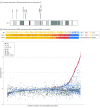Assessment of ERBB2/HER2 Status in HER2-Equivocal Breast Cancers by FISH and 2013/2014 ASCO-CAP Guidelines
- PMID: 30520947
- PMCID: PMC6439848
- DOI: 10.1001/jamaoncol.2018.6012
Assessment of ERBB2/HER2 Status in HER2-Equivocal Breast Cancers by FISH and 2013/2014 ASCO-CAP Guidelines
Abstract
Importance: The 2013/2014 American Society of Clinical Oncology and College of American Pathologists (ASCO-CAP) guidelines for HER2 testing by fluorescence in situ hybridization (FISH) designated an "equivocal" category (average HER2 copies per tumor cell ≥4-6 with HER2/CEP17 ratio <2.0) to be resolved as negative or positive by assessments with alternative control probes. Approximately 4% to 12% of all invasive breast cancers are characterized as HER2-equivocal based on FISH.
Objective: To evaluate the following hypotheses: (1) genetic loci used as alternative controls are heterozygously deleted in a substantial proportion of breast cancers; (2) use of these loci for assessment of HER2 by FISH leads to false-positive assessments; and (3) these HER2 false-positive breast cancer patients have outcomes that do not differ from clinical outcomes for patients with HER2-negative breast cancer.
Design, setting, and participants: We retrospectively assessed the use of chromosome 17 p-arm and q-arm alternative control genomic sites (TP53, D17S122, SMS, RARA, TOP2A), as recommended by the 2013/2014 ASCO-CAP guidelines for HER2 testing, in patients whose data were available through Molecular Taxonomy of Breast Cancer International Consortium (METABRIC) and whose tissues were available through the Breast Cancer International Research Group clinical trials. We used data from an international cohort database of invasive breast cancers (1980 participants) and international clinical trial of adjuvant chemotherapy in invasive, node-positive breast cancer patients.
Main outcomes and measures: The primary objectives were to (1) assess frequency of heterozygous deletions in chromosome 17 genomic sites used as FISH internal controls for evaluation of HER2 status among HER2-equivocal cancers; (2) characterize impact of using deleted sites for determination of HER2-to-internal-control-gene ratios; (3) assess HER2 protein expression in each subgroup; and (4) compare clinical outcomes for each subgroup.
Results: Of the 1980 patients in METABRIC,1915 patients were fully evaluated. In addition, 100 HER2-equivocal breast cancers by FISH and 100 comparator FISH-negative breast cancers from the BCIRG-005 trial were analyzed. Heterozygous deletions, particularly in specific p-arm sites, were common in both HER2-amplified and HER2-not-amplified breast cancers. Use of alternative control probes from these regions to assess HER2 by FISH in HER2-equivocal as well as HER2-not-amplified breast cancers resulted in high rates of false-positive ratios (HER2-to-alternative control ratio ≥2.0) owing to heterozygous deletions of control p-arm genomic sites used in ratio denominators. Misclassification of HER2 status was observed not only in breast cancers with ASCO-CAP equivocal status but also in breast cancers with an average of fewer than 4.0 HER2 copies per tumor cell when using alternative control probes.
Conclusions and relevance: The indiscriminate use of alternative control probes to calculate HER2 FISH ratios in HER2-equivocal breast cancers may lead to false-positive interpretations of HER2 status resulting from unrecognized heterozygous deletions in 1 or more of these alternative control genomic sites and incorrect HER2 ratio determinations.
Conflict of interest statement
Figures



References
Publication types
MeSH terms
Substances
Grants and funding
LinkOut - more resources
Full Text Sources
Medical
Research Materials
Miscellaneous

